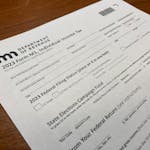As ugly a year as it has been for equity investors, conditions have improved in the last two months. The S&P 500 rallied 15% from its June 16 low and in doing so recaptured half its year-to-date losses.
That leaves the U.S. stock market at a virtual crossroads, midway between its all-time high and its 2022 bottom.
Given how much negativity was priced into equities earlier this summer, it was only a matter of time before the momentum reversed course. That said, there is very little consensus about where the market goes from here.
Even though economic growth is slowing, the strong financial condition of corporations and consumers gives us confidence that equities will offer attractive returns over the coming 12 months. It's more difficult to have conviction about what happens between now and year-end.
Here are three reasons to feel optimistic and three reasons to be concerned about the short-term outlook for stocks:
The Good
- Jobs data and consumer spending remain strong. Although big retail stocks like Walmart and Target suffered big losses this summer, that had more to do with swollen inventories and high transportation costs than a serious drop in demand. Adjusted for inflation, consumer spending continued to rise in the last quarter. All 22 million American jobs lost during the pandemic have now been added back. National unemployment (3.5%) is the lowest it's been since 1969. Although wage increases (5.2% from a year ago) have not kept up with inflation, they will likely prove more durable.
- After consecutive meetings in which the Federal Reserve raised interest rates by 0.75% (the largest such increases since 1994), Fed Chair Jerome Powell has indicated future policy decisions will be data dependent. If, in other words, inflation slows or economic data weakens, the Fed will slow or even pause rate hikes. If that comes to fruition, expect equities to react favorably.
- The numbers suggest we are in a recession and yes, that's good news relatively speaking. U.S. economic growth contracted in each of the last two quarters (1.6% in Q1, then 0.9% in Q2). Ignore the politicians who suggest "this one shouldn't count" and embrace the idea we no longer need to wonder when the next inevitable recession will hit. In terms of investor sentiment, better to rip the Band-Aid off and look forward to the economic recovery ahead.
The Bad
- It's still too early to say definitively that inflation has peaked. The latest CPI number released last week indicates price increases are moderating (8.5% inflation vs 9.1% a month earlier), but it will take more than one report to convince investors the worst is behind us.
- The S&P 500's peak-to-trough decline of 25% this year may not be "severe enough." In the nine bear markets since World War II also accompanied by a recession, the S&P fell 36% on average. Even if the June 16 low holds, a retest of those levels remains a realistic possibility.
- Geopolitical risks are elevated. Russia's war with Ukraine (and the economic sanctions it triggered) lingers without a realistic end in sight. House Speaker Nancy Pelosi's recent visit to Taiwan heightened tensions between the U.S. and China, causing some to worry about the world's supply of semiconductor microchips. Midterm elections in the U.S. add another layer of political uncertainty.
Given that corporate earnings season is wrapping up and the Fed does not meet again until Sept. 20, the most likely short-term path might be stocks trading in a tighter range between now and then, essentially waiting out the summer.
Longer term, all this speculation is less significant. U.S. stocks will reach new highs. It's just a matter of how long it takes and how many detours we encounter on this road to recovery.
Ben Marks is chief investment officer at Marks Group Wealth Management in Minnetonka. He can be reached at ben.marks@marksgroup.com. Brett Angel is a senior wealth adviser at the firm.



